I t’s an interesting time to be in the business of technology, as any channel firm or other tech influencer will tell you. The research in this report highlights a number of dynamics happening across business models, go-to-market strategies, customer interactions, human resources, and skills training. We also share findings around vertical industry specialization and explore the extent to which today’s channel firms are incorporating emerging technologies such as artificial intelligence, blockchain, virtual reality, IoT, etc., into their portfolios. Customer demand is driving a groundswell of decision-making in the channel today, a trend also explored in this report.
Key Points
Emerging technologies will be a force.
While still nascent for many channel firms, emerging technologies are nonetheless becoming a growing part of portfolios. Respondents cite them as the No. 1 driver of change across the tech ecosystem. The ability to build a business around artificial intelligence, virtual reality, blockchain, drones, IoT, etc., will take companies into a future growth path, for sure. But getting there will test firms on several fronts; most importantly, in areas of skills and training, and cost of entry.
Specialization is getting more real.
Customer demand for a technology provider with vertical industry skills and applications knowledge is on the rise. Nearly two thirds of channel firms say they embarked on a vertical specialty to satisfy customer demand and as a competitive differentiator. Embracing a niche specialty in retail, healthcare, or other sector will deliver a proven competitive advantage. But again, the challenge lies in having the right skills and training. And it’s important to distinguish “real” vertical applications specialization from the more horizontal type of infrastructure sales to customers that just happen to be in the same industry.
New types of competitors, partners.
The channel ecosystem is expanding, which is either good news or bad news for traditional partners. Mostly it depends on perspective. There are new competitors to face, but also the potential for new partners. The most prevalent new face in the ecosystem belongs to cloud-based ISVs and their SaaS-focused reseller/referral partners. Six in 10 channel firms report encountering this type of company in today’s competitive landscape. The other new competitor/partner types include digital marketing agencies, which 46% of respondents see in the market today. And roughly 2 in 10 channel firms are now competing with non-technology companies altogether, specifically accounting and law firms that influence or resell software pertaining to their respective professions.
Market Overview
Rapid change is happening across the IT channel today, affecting business models, the competitive landscape, customer types, buying patterns, M&A activity and more.
These changes are also impacting how we define the indirect channel – and even what we call it. For many practitioners, the term “channel” is reaching an expiration date; for others, it’s a label they either don’t recognize for their business, or in some cases, a term they have never heard at all. At CompTIA, we refer to something called the “business of technology,” a concept that applies to any entity involved in selling, influencing and/or creating IT solutions for their customers. The players in this tech ecosystem run the gamut from traditional resellers to newer SaaS players, to even a certain professional services firms. In total, they comprise today’s more diverse channel, whether they use that moniker or not. In this report and for the sake of brevity, the term channel will be used, but be mindful that it is inclusive of the total business of tech ecosystem described above.
Even before the emergence of new channel types, sizing this ecosystem has always been difficult, and estimates of the U.S. channel in particular tend to vary. This may be a function of definition, methodology or limitations in the ways technology companies are classified. It’s grown particularly thorny as more types of tech firms emerge.
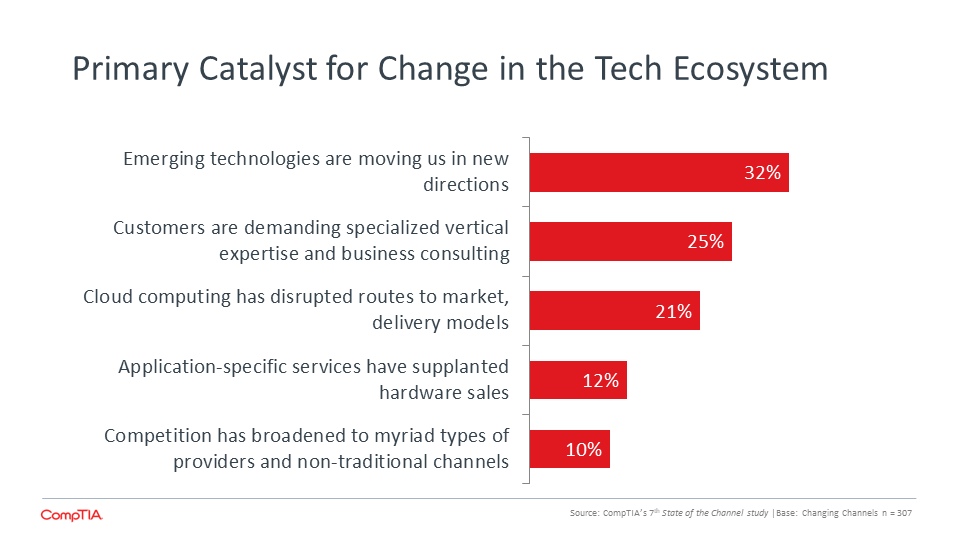

Using the U.S. Commerce Department’s North American Industry Classification System (NAICS), there have historically been primary categories associated with the IT channel. The sum of these categories equates to roughly 139,354 establishments with employees. This can be viewed as one interpretation of the size of the U.S. channel by the count of establishments.
Beyond the newcomers to the tech ecosystem, a large pool of self-employed, sole-proprietors are also peddling, recommending or servicing technology. These could be individuals providing IT consulting services, web design, mobile app development, or technical support services. Some individuals engage in these lines of business on the side, further complicating the sizing process. The self-employed segment adds another 199,756 individuals (or about 339,110 in total), resulting in an even broader interpretation of what could be considered the IT channel.
It’s an interesting time to be in the business of technology, for sure. The research in this report, CompTIA’s 7th State of the Channel, will highlight a number of dynamics happening across business models, go-to-market strategies, customer interactions, vendor relations, human resources, and training. We’ll also share findings around vertical industry specialization and the extent to which today’s channel firms are incorporating emerging technologies such as artificial intelligence, blockchain, virtual reality, IoT, etc., into their portfolios.
Prognostications For The Channel
Despite years’ worth of pundits predicting gloom and doom for the channel, the ecosystem is chugging along nicely, reinvigorated in many ways by a whole new set of players. Meanwhile, optimism about the future has grown. In 2016, for example, 63% of respondents from CompTIA’s 6th Annual State of the Channel study said they were generally optimistic about the channel’s future; in 2018 that number rose to 75%. Gloomy outlooks have tempered as well. The number of channel firms expressing pessimism about the future over the same two years dropped from 16% to 5%.
While the reasons for more optimism are myriad, it’s clear that attitudes toward the impact of cloud computing have transformed from nearly a decade ago, including over the last two years. The opportunity presented by cloud is cited as the No. 1 reason to feel positive about the channel’s future. More than half (56%) of respondents said this to be the case compared with 39% that felt this way in 2016. Cloud has always been a lightning rod for the channel; one part loving it, one part hating it, and nearly no part able to ignore it. As time has gone on, however, the reality that cloud is now the fundamental enabling infrastructure for IT has sunk in and the channel has had to decide how they were going to use it.
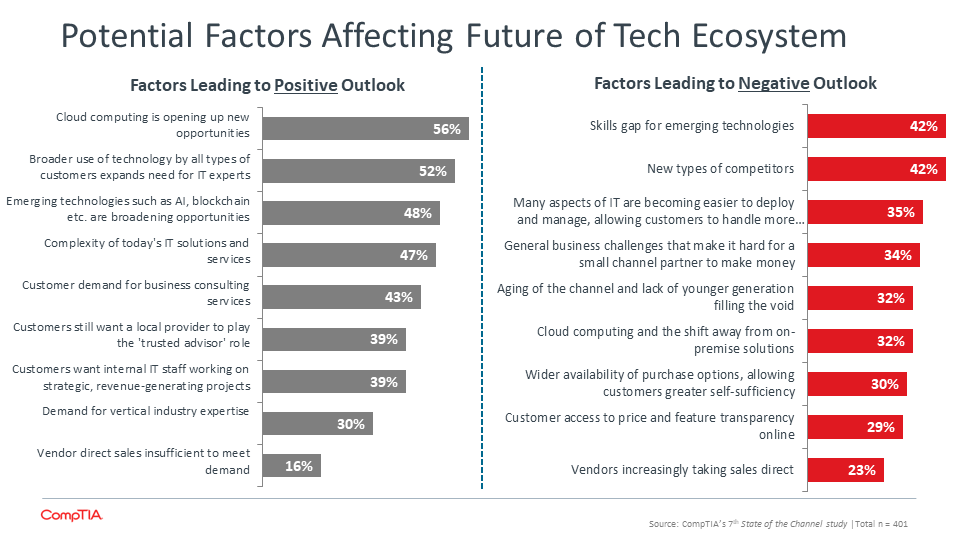
Nearly across the board, respondents in 2018 ranked factors that bolster good feelings about the channel’s future significantly higher than they did two years ago. The broader use of technology among customers, for example, inspired optimism for the future in 37% of 2016’s respondents; in 2018 that figure jumped to 52%. One possible reason for the sharp increase is the growing interest and adoption of emerging technologies, which will require new skill sets and a learning curve for many customers – a learning curve the channel hopes they will tackle with the help of third party experts.
Ironically, however, many channel firms are not yet experts in disciplines such as blockchain, artificial intelligence, virtual reality and the like, so in essence they have their own learning curve to overcome. Indeed, respondents ranked the skills gap for emerging technologies the No. 1 reason for a pessimistic outlook for the future, up 12 percentage points from 2016. Additionally, when asked what things will be needed to help ensure hope for the channel’s future, 54% of respondents cited both technical and business training for themselves, while 51% identified the need for skilled workers, particularly in the areas of emerging tech. Both percentages represent a significant jump from 2016.
A related area of concern centers around the rise of new competitors in the channel. Today, born in the cloud players, SaaS specialists and non-traditional partners such as accounting firms all influence the sale of technology. But while more competition can be cause for alarm in some circles, it should also be cause for hope. The emergence of these newer tech influencers is both growing the channel ranks and may well be positioning the entire ecosystem better for the future.
Services & Solutions Offered
While emerging technologies are the talk of the industry, they do not represent the bread-and-butter offerings sold by the majority of today’s channel firms. Most companies continue to drive the bulk of their revenue from a more established set of services and solutions, as well as from business models such as managed services.
Indeed, managed services is one of the top offerings provided by a large swath of channel firms, most notably medium- and large-sized entities. And while admittedly it’s been a long, slow march to transform from a mostly product-based transactional business to a services-based recurring revenue operation, a majority of today’s channel firms now at least offer some managed services to go along with other products and solutions. It is important to note in this discussion that most channel firms, especially those coming from the more traditional ranks vs. newer entrants, remain hybrid in nature. They might identify as an MSP, but also conduct some hardware sales, integration services, cloud and SaaS work, and other activities.
- 64% of firms expect their mix of offerings to change to new types in next two years
- 22% of firms expect no change in portfolio
- 14% of firms do not yet know
Consulting work is increasingly popular, especially among the smaller-sized segment of the channel, though it is a prominent revenue driver for companies of all sizes. Roughly half (49%) of all respondents report consulting work – both technical and business in nature – to be one of their main revenue streams over the last two years. Among companies with between 1-49 employees, 55% cite consulting as one of the services they offer. This is far and away the most prevalent piece of their portfolio, followed by break/fix services at 38% incidence and managed services at 35% incidence.
Why consulting? For one, it can be lucrative, with margins rivaling what the best MSPs can garner at up to 50% depending on the type of consulting engagement. We can thank the cloud in large part for the surge in this type of work; for example, many customers are now able to self-provision solutions directly, but are overwhelmed by their choices. Of the thousands of SaaS applications in the cloud today, it’s hard to know which will best meet a desired business outcome. In comes the consultant, who is versed in a wide variety of cloud applications and is able to vet a selection to suit individual customer needs. Consultants can also assist with long-term business strategies, and help address how cloud solutions integrate and interact with a customer’s full IT and business environment.

Two solutions types, hardware sales and digital marketing services, are among the least frequently offered in the last year, and yet in reality they are on opposite trajectories. Twenty-seven percent of respondents reported offering hardware sales in the last year, as did an equal percentage that said they provided digital marketing services. Looking ahead to the next two years, 64% expect hardware sales to increase, while 13% predict a decrease in sales. For those offering digital marketing services, 72% expect an increase in sales, while just 7% cite a decrease. Hardware sales have been on a downward slope for some time as firms move more into services and recurring revenue, but a discipline like digital marketing is a new domain for many traditional solution providers and can be expected to continue on a growth path.
Top 5 Solutions/Services Driving Revenue Last 2 Years
- Managed services (33% of respondents)
- Software as a Service (32%)
- Application development (26%)
- Security infrastructure/application services (26%)
- Consulting (23%)
Vertical Market Focus Trends
Technology can be a tough market to navigate, leaving channel firms today scouting for every opportunity to differentiate themselves. This is especially true as the ranks of the channel expand to more non-traditional players that possess new sets of skills, different vendor partners and/or routes to market. One approach that is increasingly popular is the pursuit of a vertical industry specialization. Focusing on an industry allows channel firms to move beyond horizontal solutions to become more granular in what they do; in effect, attaining know-it-all status in a niche market such as healthcare, retail, manufacturing and beyond.
Plus, customers love it. Their tech providers are speaking their language. At its core, applications’ expertise is key to a vertical specialty. Most basic infrastructure engagements – devices, networking, security and other hardware – are repeatable; it’s the same sales and implementation process whether you are dealing with a small doctor’s office, a car dealership or a manufacturing plant. But it’s understanding the software, all of those specific-use applications that pertain to the industry in question, that will earn you true vertical street cred.
Applications-specific vertical expertise fits well in today’s cloud-based software world. Many cloud-based ISVs are developing discrete applications tied to specific industries. These are often small firms lacking a largescale sales operation and eager to grow. As a result, many are beginning to experiment with indirect channel partners to grow their footprint and penetrate various customers segments.
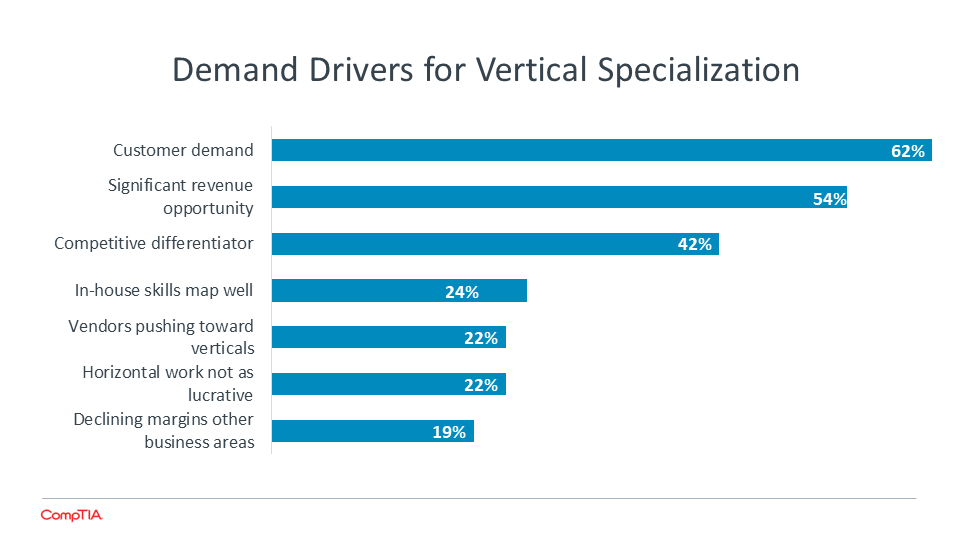
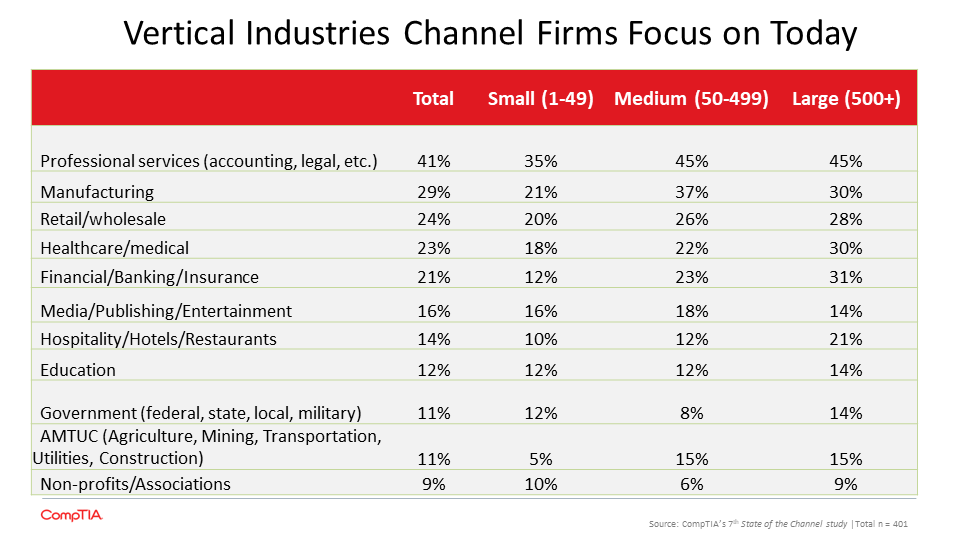
All channel respondents in this study reported at least some vertical industry work within their business, with three quarters describing that work as important. Of that 75%, 4 in 10 deemed their vertical business as very important. It is most likely this group that has made a concerted effort to make one or more vertical industries a strategic focus for their firms, and a significant source of revenue. It’s important to note that many respondents that report doing vertical work may only be selling horizontal infrastructure solutions to a cluster of customers in the same industry. This is not the same as becoming an expert in the applications and business processes that an individual vertical such as retail requires. That level of expertise is what truly comprises vertical industry focus and is what many ISVs, vendors and customers are seeking in their channel partners. Customer demand is the No. 1 driver for doing vertical-specific work.
Large- and medium-sized have a higher incidence of vertical industry work than do smaller firms and they tend to play in more than one industry. This is clearly a function of size, resources and bandwidth. Forty-five percent and 42%, respectively of large- and medium-sized firms attribute more than half of their revenue in the last fiscal year to projects related to vertical industries, compared with 31% of smaller channel firms that report the same.
Emerging Tech: Opportunity or Threat?
Artificial intelligence. Drones. Internet of Things. Blockchain. These are but a few of the emerging technologies disrupting the industry today. Consider that by 2021, research firm IDC predicts that emerging technologies, including IoT solutions, robots and drones, augmented reality and virtual reality (AR/VR) headsets, and 3D printers, will account for almost a quarter (23%) of total information technology spending.
While often placed in one universal bucket, many of these technologies are quite distinct from one another, while others are truly complementary. That leaves lots of choices from a channel perspective. It’s not unlike the advent of cloud computing 10 years ago, which prompted a host of questions from solution providers: “Is this an opportunity for my business or a threat?” “SaaS, PaaS or IaaS?” “Which, if any of these technologies are a good fit for what we do today?” “Can we find the right people to drive these initiatives?”
All valid questions. But based on study findings, sentiment for emerging tech is mainly positive, despite this maze of options to consider. And while many channel firms are early on the adoption curve, they mostly view these new paradigms as a business opportunity, one that despite inevitable growing pains will eventually reap rewards. To wit, three quarters of respondents say that emerging tech represents a revenue opportunity, compared with just 14% that consider it a threat to the channel and another 9% that are ambivalent to its potential.
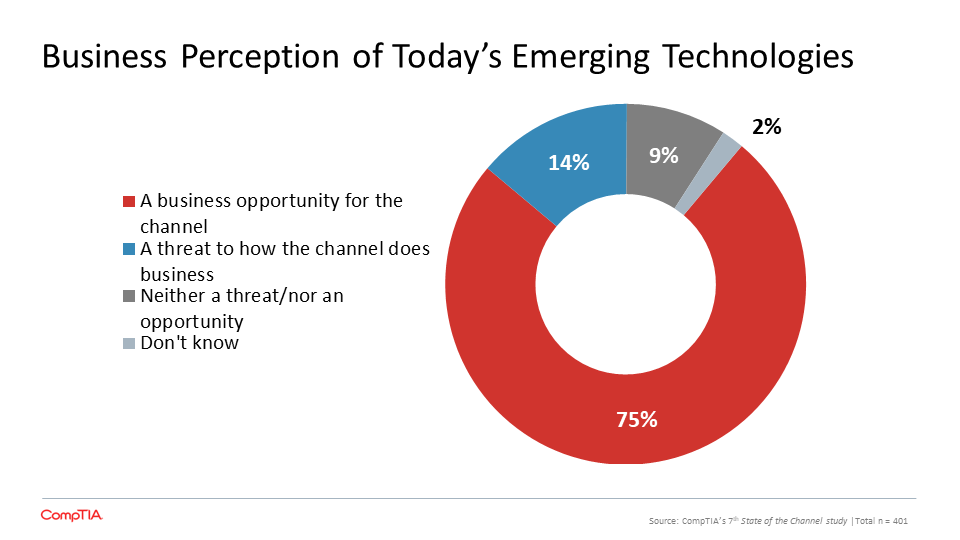
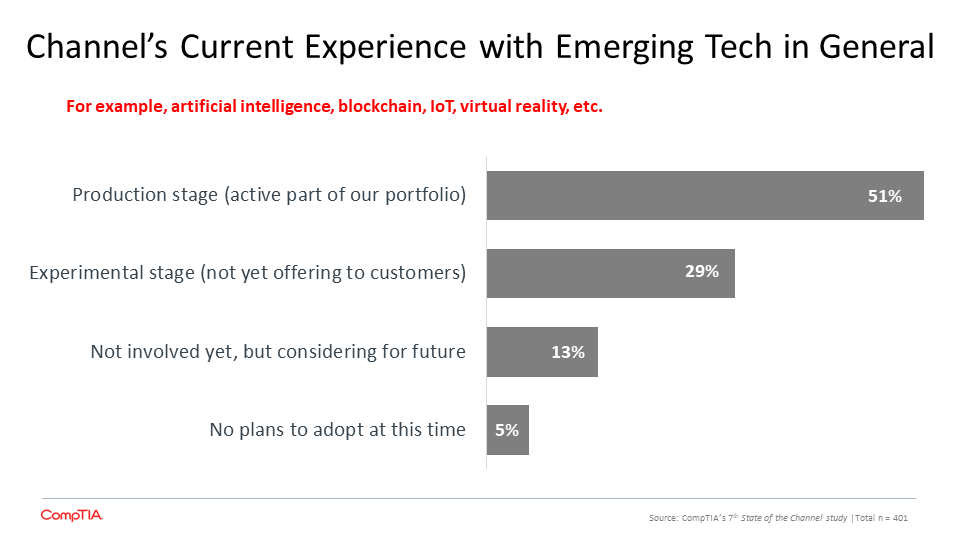
Where are today’s channel firms at with emerging technology? Half report being in a production stage, meaning that one, some or all of these technologies are an active part of their portfolios today and are being sold to customers. This percentage creeps higher the larger the channel firm is in size, which makes sense from a resource, skills staffing standpoint. Also understandably, respondents in technical positions at their firms are more likely to report being in the production stage with emerging technologies compared with staff on the business side of the house. Fifty-seven percent of technical workers said they are working with at least some emerging tech as part the portfolio vs. 43% of business workers (sales, marketing, etc.).
42% of respondents cite a skills gap for handling emerging technologies as a factor that could prompt pessimism about the channel’s future.
All this being said, a caveat is in order. The reality is that many of these emerging technologies are very nascent in terms of practical products on the market and widespread adoption among customers. The channel’s experience with these technologies is likewise new. It is quite likely that the 51% of respondents that said they are in production mode with emerging techs could be talking about a single customer engagement or experience. Whether they are at this point garnering significant revenue from these technologies remains to be seen. As the data reveals, most channel firms continue to reap the bulk of their sales from existing business models, products and services.
Looking ahead, however, the opportunity behind these technologies is promising. And channel firms are doing much legwork to get up to speed on the details, including taking steps to hire the right talent to deliver on their initiatives in this space. Consider that half of all respondents expect most of their revenue in the next two years to come from net-new business. It stand to reason that much of that new business could be predicated on emerging tech solutions.
When it comes to familiarity with individual emerging techs, it’s no surprise that IoT rises to the top of respondents’ knowledge list. Forty-seven percent of respondents professed significant familiarity with IoT, with another 39% saying they had at least some knowledge of the technology. IoT solutions, which encompass myriad elements from hardware sensors and other devices to data capture/analytics software, have been on the market longer than most of the other emerging techs. And many channel firms have at least begun working with IoT in some fashion, chiefly selling and installing devices along with providing some managed services around those devices.
Medium- and large-sized channel firms had a higher degree of familiarity with IoT than smaller companies. Roughly 6 in 10 of the two larger groups vs. 30% of small firms said they had significant knowledge of IoT. Not surprisingly, IoT solutions (both hardware and software) ranked at the top of the list of emerging technologies that respondents are either experimenting with or currently offering. The next two technologies after IoT were artificial intelligence and virtual reality.


Across the board, tech-oriented workers reported having the most detailed working knowledge of emerging tech compared with their colleagues on the business side of the house, which makes sense as they represent ground zero for testing out new products and solutions. In the aggregate, roughly 45% of all respondents said they had some knowledge/familiarity with the each individual emerging technology on the list, from IoT to robots to blockchain. About a quarter of all respondents acknowledged little familiarity with these solutions, blockchain being the one technology with the largest knowledge gap.
With any new endeavor, come challenges; emerging tech is no different. Available resources, skills training needs, hiring difficulties, and the fear of the unknown are among the hurdles that channel respondents say they are grappling with as they dive into these new areas. This gap builds upon existing challenges the channel is facing as it continues efforts at digital transformation. The emerging tech challenges are fairly consistent in hitting channel firms of all sizes, though medium-sized companies (50-499 employees) appear hardest hit. This is likely due to the fact that the largest firms have the resources and reach to deal with cost of entry and skills gap challenges, while small firms are only moving slowly into emerging tech as needed. Medium-sized firms are large enough to dive in, but typically face some resource constraints.
Major Factors Behind Decision to Offer Emerging Techs
- Customer demand (72% of respondents)
- Better revenue opportunity than current portfolio (59%)
- Competitive differentiator (52%)
- To avoid obsolescence (44%)
- Vendors are pushing us in this direction (32%)
New Competitors, New Partners
As mentioned previously, the channel, or whatever you choose to call it, is now comprised of a whole new segment of players. For more traditional channel firms, this expanded ecosystem is either good news or bad news – or a little of both, depending on perspective. There are new competitors to face, but also the potential for new partners to work with.
The most prevalent new face in the ecosystem belongs to cloud-based ISVs and their SaaS-focused reseller/referral partners. Six in 10 channel firms report encountering this type of company in today’s competitive landscape. Think of the legion of Salesforce ISVs and all their partners, along with other cloud-based distribution ecosystems such as AppDirect’s or Pax8’s. The other new competitor/partner types include digital marketing agencies, which 46% of respondents see in the market today. Then there are vertical industry applications specialists that a third of respondents bump into in the trenches. This group is often part of the broader SaaS universe. Finally, roughly 2 in 10 channel firms are now competing with non-technology companies altogether, specifically accounting and law firms that influence or resell software pertaining to their respective professions.
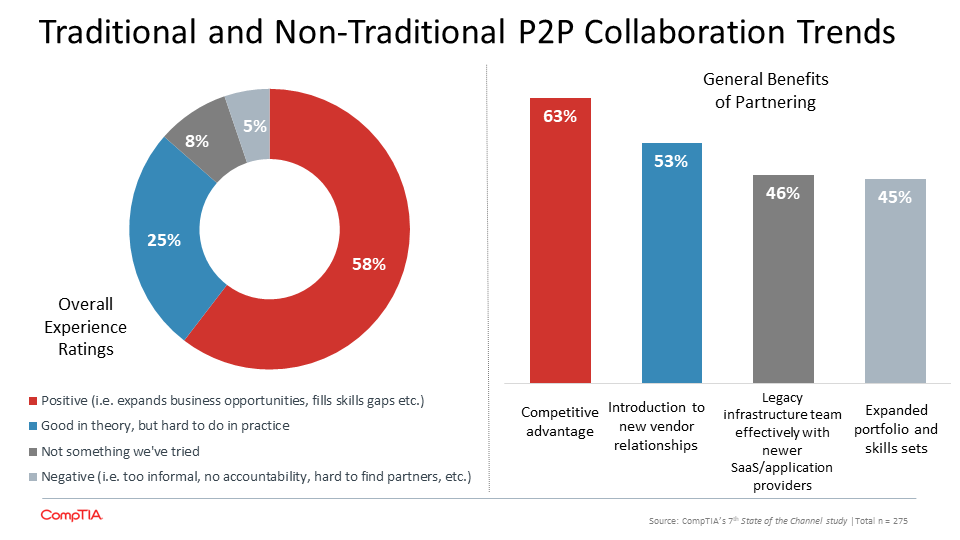
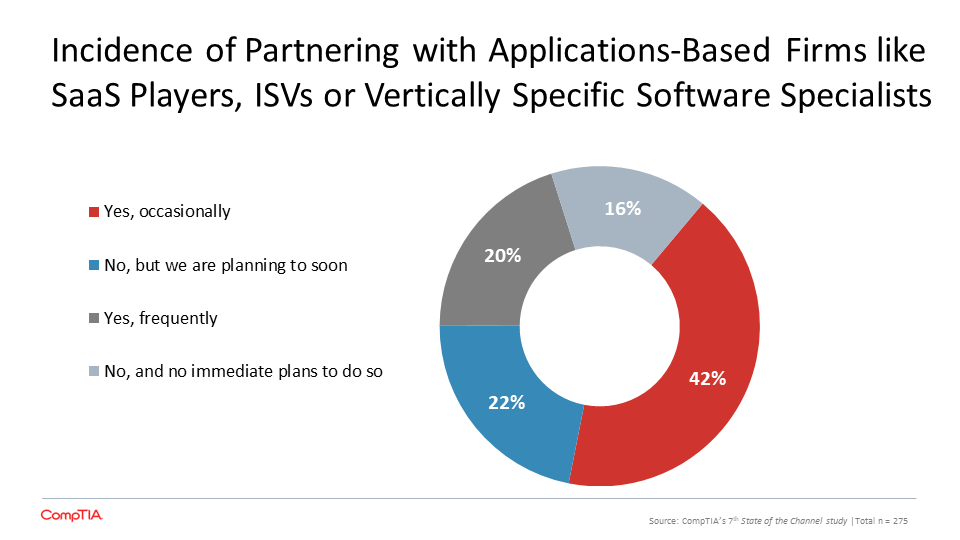
Larger firms are experiencing this wave of new entrants at a bigger scale than the smaller channel firms, but not by much. It's a trend that is reaching across the entire channel, one that’s expected to continue into the years ahead. Cloud computing is driving much of the new wave of channel types, along with emerging technologies and the changing ways in which customers want solutions and services delivered.
The changing ecosystem is having a direct impact on how channel firms go to market. Two in 10 say their GTM model has changed dramatically in the last two years, while 54% said it’s changed somewhat. Just a quarter say their approach has remained the same. Customer demand is the main reason for cited these changes. Not only are many traditional customer buying habits shifting because of the easy accessibility and self-provisioning aspects of IT in the cloud, the face of the customer is literally changing. More line business executives are making tech-purchasing decisions. As a result, many channel firms have had to reorient their sales and marketing strategies in order to target this new buyer type.
Partner-to-partner (P2P) collaboration has always been talked about as a bit of holy grail in the channel. But today it is gathering some momentum as the ecosystem expands. As vertical and application specialization proliferates, channel firms more steeped in horizontal infrastructure are seeing an upside to filling a gap in their portfolio by partnering vs hiring.
Nearly 6 in 10 respondents said they have had a positive experience with this type of partnering arrangement. The benefits, they contend, are expanded business opportunities and skills gap narrowing. It’s not always an easy model, but most agree it’s a good idea. A quarter of respondents called P2P between infrastructure firms and applications specialists good in theory, but sometimes difficult to do in practice. Often this is the result of partnerships that are handshake only in nature, lacking in formal rules of engagement, agreed-upon lines of accountability and repetitive processes.
Appendix
Research Methodology
This quantitative study consisted of an online survey fielded in June-July 2018 to 401 U.S. IT businesses, yielding an overall margin of sampling error proxy at 95% confidence of +/- 4.9 percentage points. Sampling error is larger for subgroups of the data.
As with any survey, sampling error is only one source of possible error. While non-sampling error cannot be accurately calculated, precautionary steps were taken in all phases of the survey design, collection and processing of the data to minimize its influence.
CompTIA is responsible for all content and analysis. Any questions regarding the study should be directed to CompTIA Research and Market Intelligence staff at [email protected].
CompTIA is a member of the market research industry’s Insights Association and adheres to its internationally respected Code of Standards.
Read more about Industry Trends.


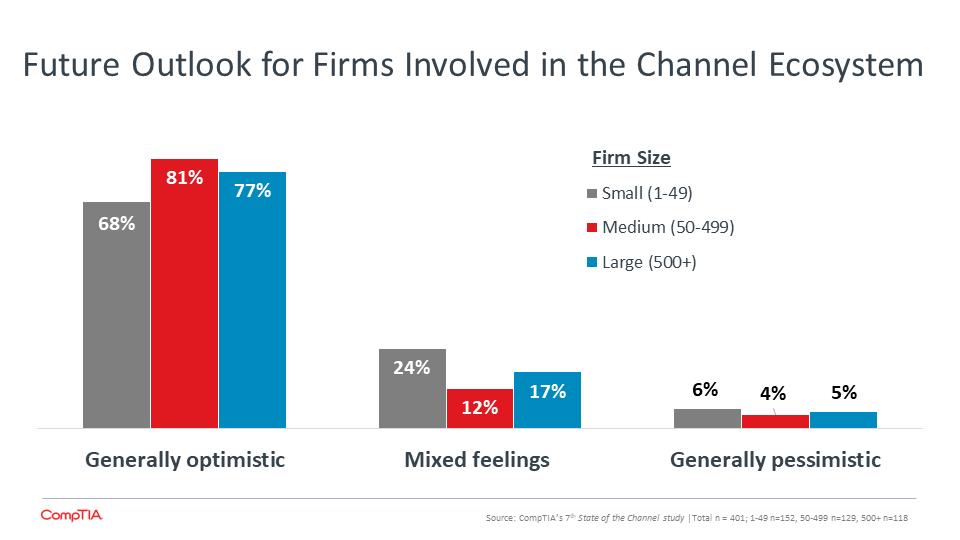
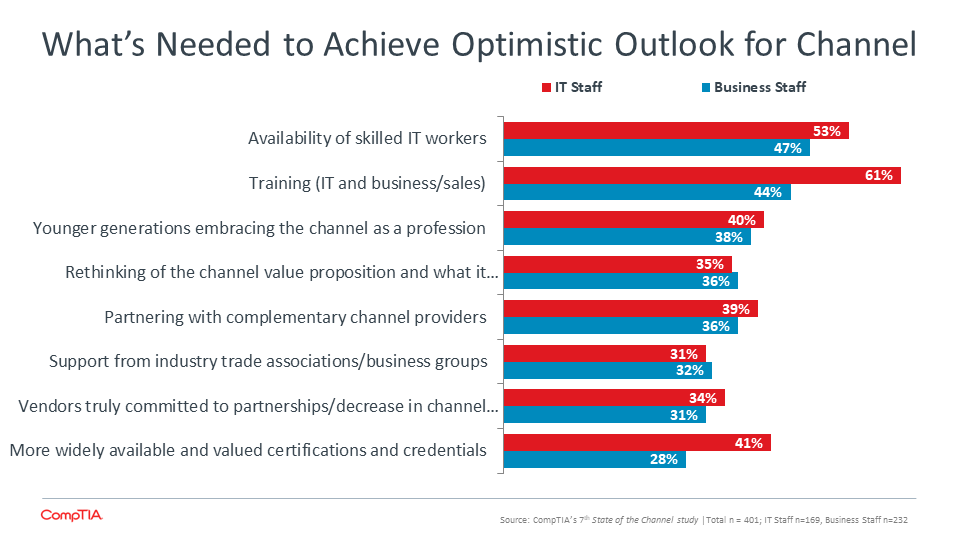


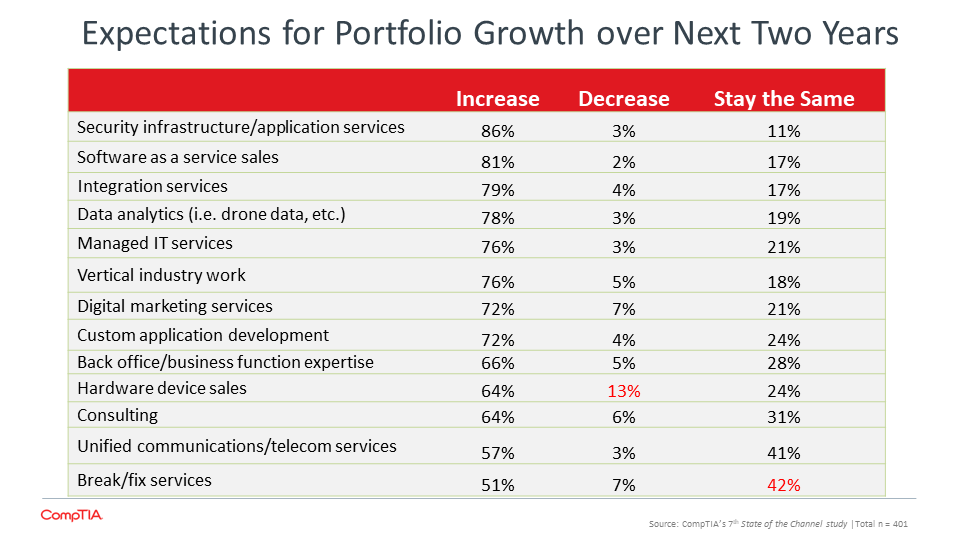

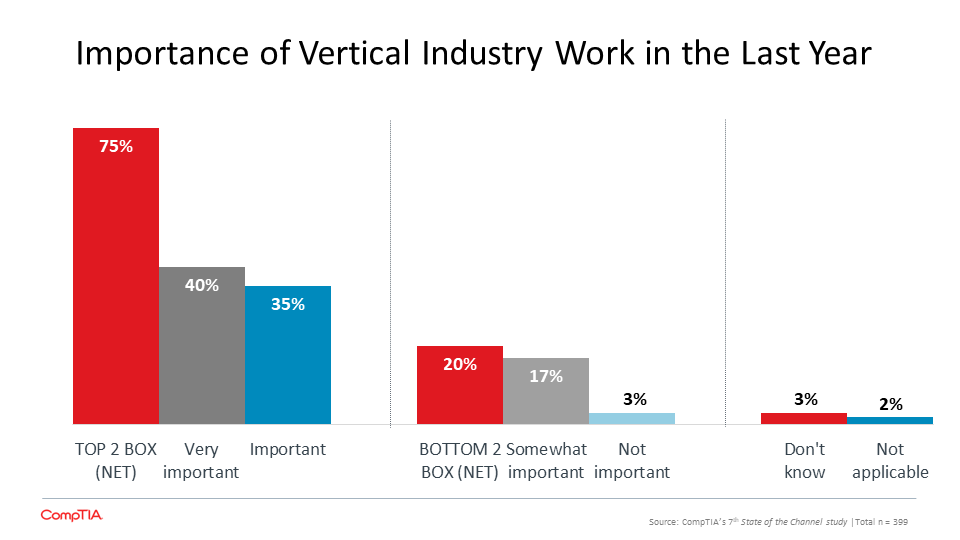
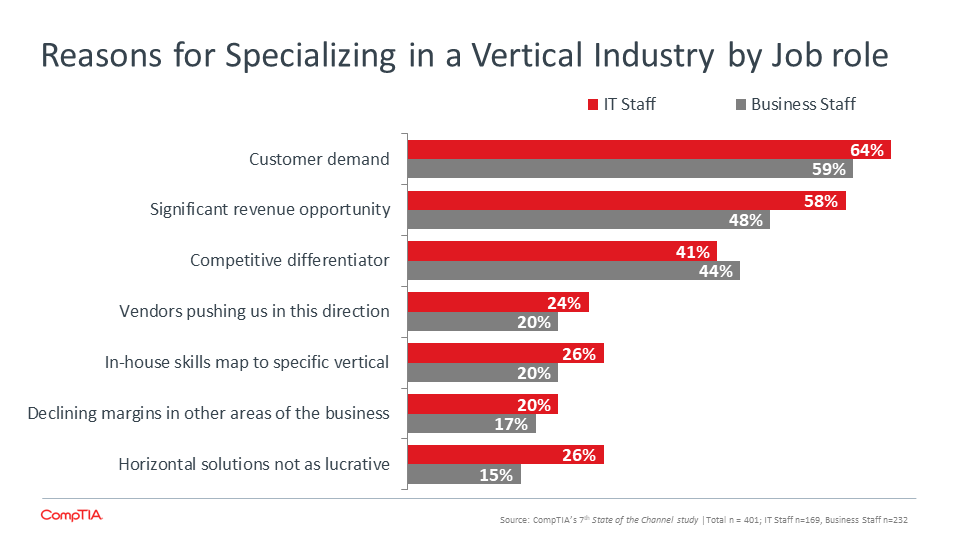
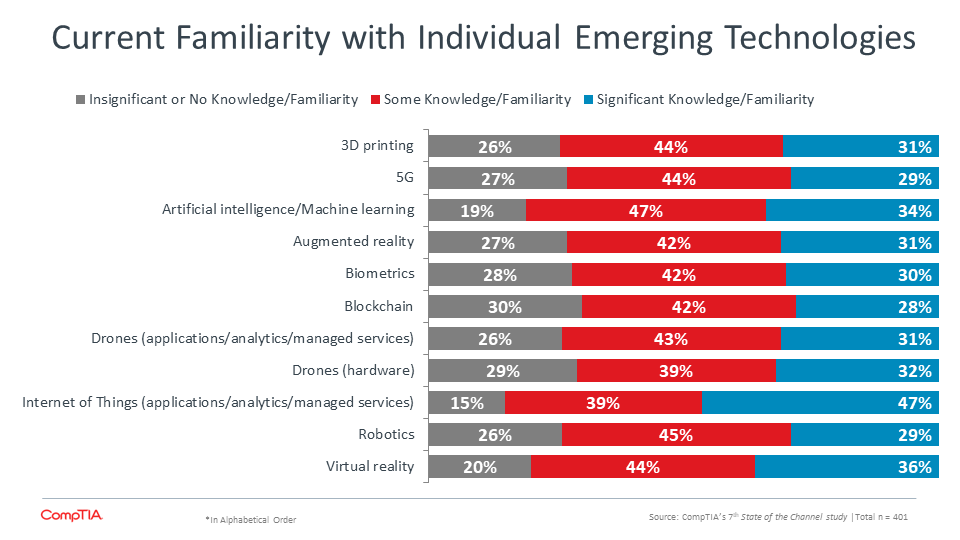
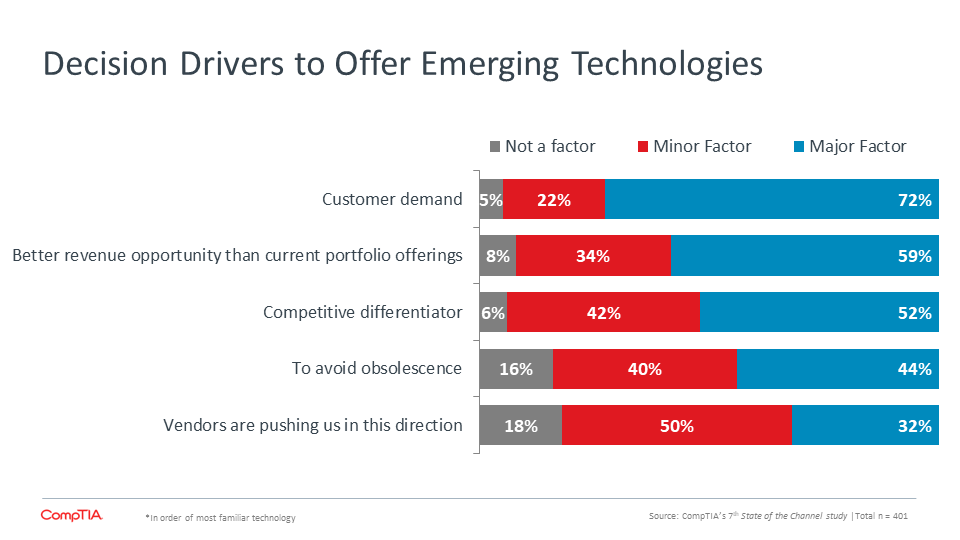


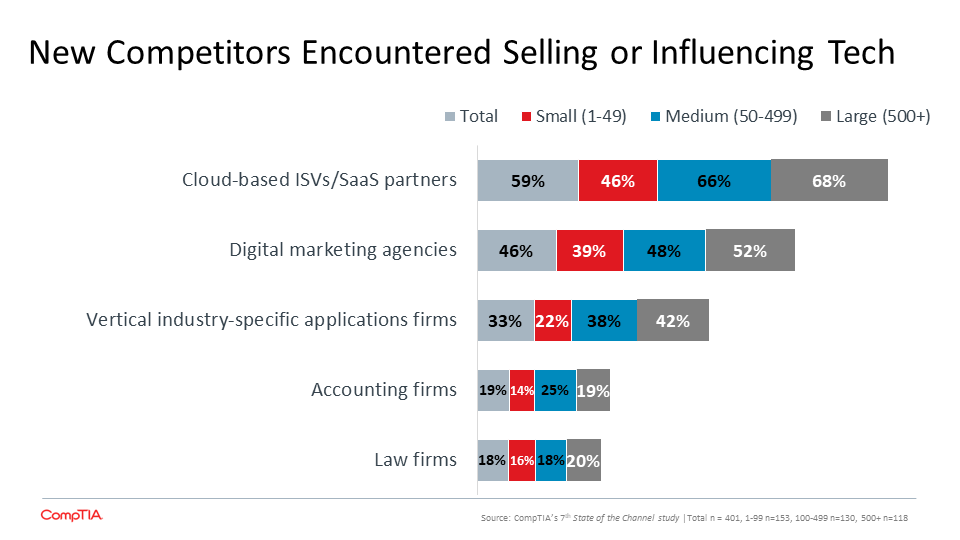
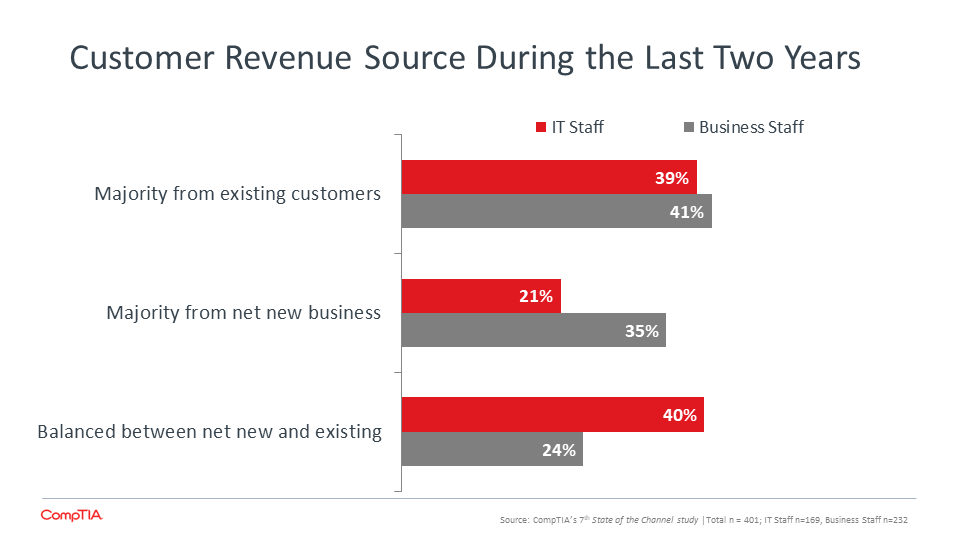

 Download Full PDF
Download Full PDF